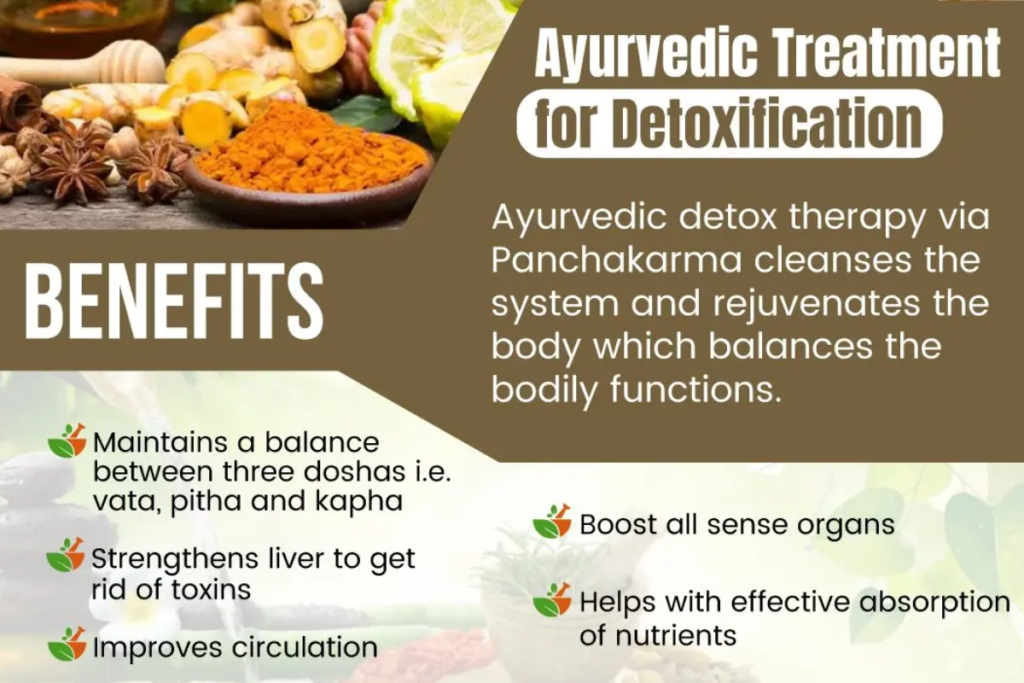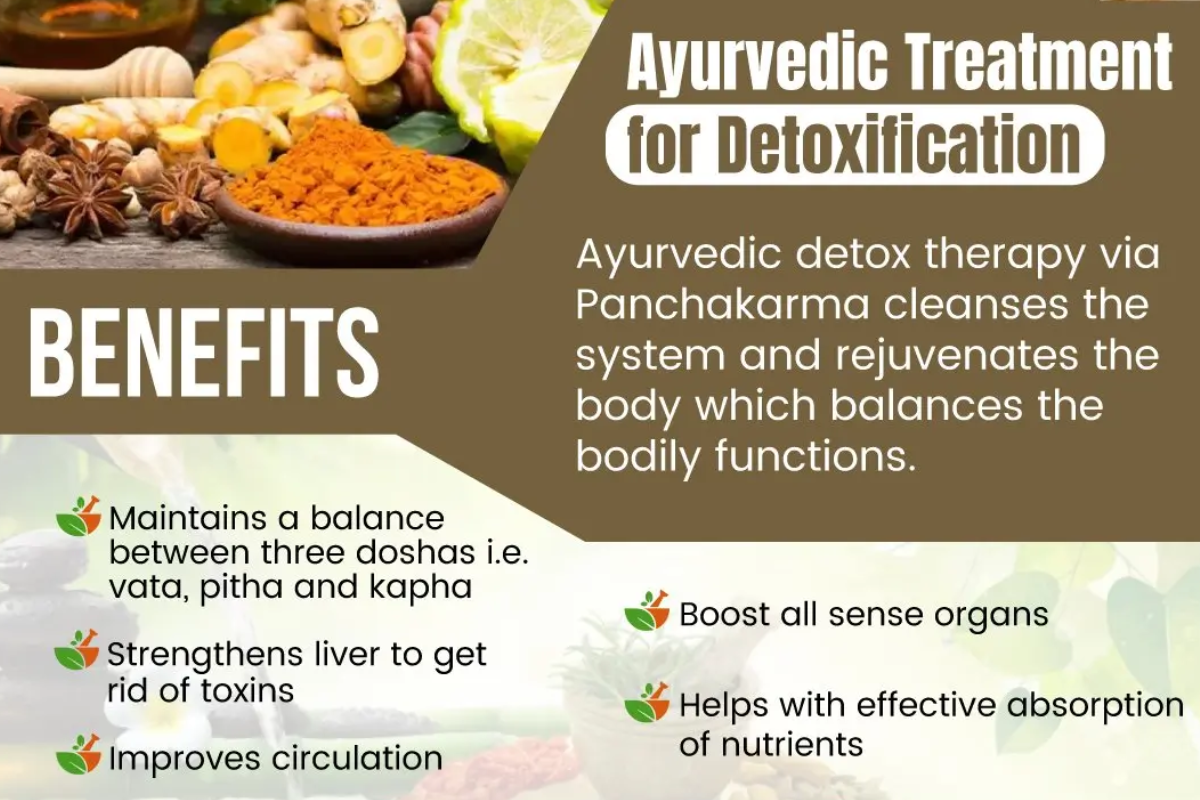Table of Contents
Toggle
🧘Introduction to Ayurvedic Detoxification
Ayurveda, the ancient Indian system of medicine, offers a time-tested approach to detoxification and healing. At its core, Ayurvedic detoxification is about removing ama (toxins), balancing the doshas (Vata, Pitta, Kapha), and restoring harmony in body, mind, and spirit.
At Adyant Ayurveda, we specialize in providing the best Ayurvedic detox treatment in Bangalore, using personalized Panchakarma therapies. These treatments go beyond a superficial cleanse—they reset your body from the inside out.
📲 Book a Free Consultation Today – Download our app “AyurCare“ from the Play Store and begin your detox journey!
🔬 Understanding Ayurveda: A Holistic Science
Ayurveda views health as a dynamic equilibrium between the three doshas:
- Vata (Air + Ether): Movement, circulation, and elimination
- Pitta (Fire + Water): Digestion, metabolism, and temperature
- Kapha (Earth + Water): Structure, immunity, and lubrication
When these doshas become imbalanced, ama accumulates and leads to disease. Ayurvedic detoxification restores this balance and purifies the system.
Ama forms due to poor digestion (mandagni), improper food combinations, sedentary lifestyle, emotional stress, or seasonal transitions.
Spring (Vasanta Ritu) and Autumn (Sharad Ritu) are considered ideal seasons for detoxification in Ayurveda to prevent seasonal diseases.
🌀 Ayurvedic Detoxification Process
A well-planned detox process is divided into three phases:
1. Purvakarma (Preparation Phase)
- Deepana & Pachana – Ignite digestive fire
- Snehana – Internal and external oleation
- Swedana – Herbal steam therapy
2. Pradhankarma (Main Detox Phase)
- Panchakarma procedures: Vamana, Virechana, Basti, Nasya, Raktamokshana
3. Paschatkarma (Post-Detox Phase)
- Samsarjana Krama (gradual diet)
- Rasayana therapy (rejuvenation)
- Continued lifestyle and dietary adjustments
💠 Panchakarma: The Heart of Ayurvedic Detox
✅ Vamana – Therapeutic Emesis
Ideal for Kapha imbalance. Treats obesity, allergies, and asthma.
✅ Virechana – Purgation Therapy
For Pitta disorders. Effective in liver issues, skin diseases, and acidity.
✅ Basti – Ayurvedic Enema
Addresses Vata-related conditions like arthritis, sciatica, and PCOD.
✅ Nasya – Nasal Therapy
Best for ENT and head-related disorders, including sinusitis, migraines.
✅ Raktamokshana – Bloodletting
Purifies blood. Helps in acne, eczema, varicose veins, and gout.
✅ Indications for Ayurvedic Detox
- Digestive problems (IBS, bloating, indigestion)
- Skin issues (psoriasis, acne, eczema)
- Respiratory diseases (asthma, allergies)
- Joint and nerve disorders (arthritis, sciatica)
- Hormonal and metabolic disorders
- Chronic fatigue and low immunity
- Mental stress, anxiety, and insomnia
- Obesity and lifestyle disorders
❌ Contraindications for Ayurvedic Detox
- Pregnancy and lactation
- Acute infections or high fever
- Severe anemia or organ failure
- Cardiovascular conditions (without clearance)
- Very young or elderly (without supervision)
- Acute mental disorders
- Menstruating women (during some procedures)
🌟 The Benefits of Adyant Ayurveda’s Ayurvedic Detox Treatments
- ✔ Elimination of ama toxins
- ✔ Improved digestion and metabolism
- ✔ Balanced doshas and mental clarity
- ✔ Skin glow and healthy weight loss
- ✔ Stronger immunity and vitality
- ✔ Holistic stress relief
Looking for Ayurcedic detox at Home in Bangalore, now possible with Adyant Ayurveda Home Care services. Book Your Appointment Now!.
Detox Protocol Based on Dosha:
| Dosha Imbalance | Detox Therapy | Common Conditions |
|---|---|---|
| Kapha | Vamana | Obesity, Sinusitis, Cough |
| Pitta | Virechana | Acne, Hyperacidity, Liver Issues |
| Vata | Basti | Constipation, PCOD, Sciatica |
| Head/ENT | Nasya | Migraine, Hair Fall, Snoring |
| Blood | Raktamokshana | Eczema, Acne, Gout |
🍵 Recommended Spices and Herbs for Detox
- Turmeric – Anti-inflammatory, liver detox
- Ginger – Digestion, circulation
- Cumin & Fennel – Bloating and gas relief
- Fenugreek – Liver and sugar metabolism
- Trikatu – Digestive stimulant
🌿 Ayurvedic Herbs for Detoxification
- Triphala – Colon cleansing
- Neem – Blood purifier
- Manjistha – Lymph detox
- Guduchi – Immune and liver tonic
- Ashwagandha – Stress reliever
- Tulsi – Respiratory system cleanser
☕ Pro Tip: Sip warm water throughout the day to enhance detox effects.
🧖♀️ Post-Detox Care
- Follow Samsarjana Krama (light diet)
- Regular Abhyanga (self-massage with medicated oils)
- Yoga & Pranayama to aid recovery
- Daily use of Rasayana herbs
- Avoid processed and ama-forming foods
📊 Scientific Evidence Supporting Panchakarma
Studies from Harvard Medical School and Kripalu Institute indicate:
- Panchakarma improves emotional well-being
- Reduces oxidative stress and inflammation
- Promotes health-enhancing behaviors
🏥 Why Choose Adyant Ayurveda?
- 🕉️ Over 25 years of expertise in Panchakarma treatment
- 👨⚕️ Successfully treated more than 100,000 patients
- 🌿 100% personalized detox plans based on Prakriti
- 🚀 Experienced Ayurvedic doctors and Panchakarma therapists
- 🏥 Four fully-equipped centers across Bangalore
- 🌟 Integrated care: diet, yoga, herbs, counseling
- 📆 Long-term follow-up and post-detox support
❓ FAQs: Ayurvedic Detoxification
What is Ayurvedic detoxification?
A cleansing therapy to eliminate toxins, rebalance doshas, and revitalize your body.
How long does a Panchakarma detox take?
Typically 7–21 days, depending on your body type and goals.
Is detox suitable for everyone?
Yes, but it must be supervised by an experienced Ayurvedic doctor.
What can I eat during detox?
Easily digestible meals like kitchari, herbal teas, and soups. Avoid heavy, spicy, fried, and sugary foods.
Will Ayurvedic detox help me lose weight?
Yes, especially for Kapha-related obesity, water retention, and sluggish metabolism.
Are there any side effects?
Temporary fatigue, headache, or skin eruptions may occur—a sign of the healing process.
Can I do a detox at home?
Basic practices like Triphala and dietary changes can be done at home. Full Panchakarma should be clinic-based.
Why is Panchakarma different from other detoxes?
It doesn’t just flush toxins—it resets the entire system by addressing root imbalances.
How should I prepare for detox?
Reduce heavy foods, alcohol, and caffeine. Eat simple meals and consult your Ayurvedic doctor.
How do I maintain results after detox?
Follow daily routines, eat seasonal foods, practice mindfulness, and stay connected with your Ayurveda consultant.
🧭 Conclusion: Reclaim Your Health with the Best Ayurvedic Detox Treatment in Bangalore
Ayurvedic detoxification isn’t just a cleanse—it’s a powerful reset for your entire being. Through Panchakarma therapy, time-tested herbal formulations, and expert, personalized care, Ayurveda helps restore balance to the body, mind, and spirit.
✍️ Supportive therapies such as Marma Chikitsa (vital point therapy), Kizhi (herbal poultice), and Shirodhara are often integrated with Panchakarma detox therapies to enhance relaxation and promote deep healing.
📲 Take the first step toward holistic health – Download our app “AyurCare” from the Play Store and start your wellness journey with Adyant Ayurveda, trusted for delivering the Best Ayurvedic detox treatment in Bangalore.
Visit our branches near you:
📍 Jayanagar
📍 Indiranagar
📍 Kalyan Nagar
📍 Rajarajeshwari Nagar
Cleanse. Rejuvenate. Heal – the Ayurvedic way.
Adyant Ayurveda | Bangalore’s Trusted Panchakarma & Ayurvedic Wellness Center



